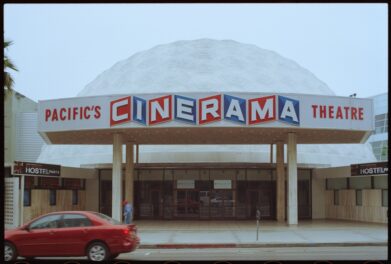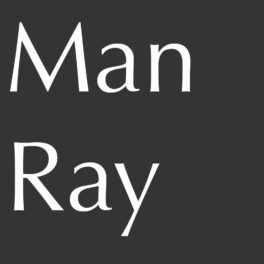
Launching today on getty.edu is the online exhibition Bauhaus: Building the New Artist, which has been more than a year in the making. The exhibition explores the Bauhaus school’s unique approach to teaching and learning through rare materials from the Getty’s archives. It also offers interactive features that invite you to try your hand at student exercises developed by Bauhaus luminaries Vassily Kandinsky and Josef Albers, as well as a customized animation of Oskar Schlemmer’s iconic theater production The Triadic Ballet.
The online exhibition is complementary to, but quite different from, a physical gallery exhibition at the Getty Research Institute, Bauhaus Beginnings. The gallery exhibition explores the origins of the Bauhaus and draws on other rare material in the Getty archives.
In this post, three members of the cross-disciplinary team who created the exhibition—the project manager, UX/visual designer, and content strategist/editor—describe how we conceptualized the site, the design metaphor for online exhibitions we developed for the project, and the editorial and production process that got us to launch.
Creating An Online Exhibition from the Getty Archives
Uma Nair, Project Manager
The Getty Research Institute holds rich archival materials related to the Bauhaus in its collections: not only rare prints, drawings, and photographs, but also student exercises and instructors’ teaching aids and notes, which offer insight into the novel learning and teaching approaches at the school.

The Getty archives hold rare and unique materials representing Bauhaus student work. One example featured in the online exhibition: Light-dark contrast study for Johannes Itten’s Preliminary Course, 1919, Friedl Dicker. Charcoal and pastel collage on black paper, 32.5 x 22.5 cm. Bauhaus Drawings and Prints by Friedl Dicker. The Getty Research Institute, 920030
To mark the 100th anniversary of the founding of the Bauhaus, the online exhibition explores a seminal early phase in the history of the school. It also turns scholarly attention to student projects at the Bauhaus in an effort to develop an alternate history beyond one solely of the masters (as Bauhaus instructors were known).
In 2017 the digital team at the Getty Research Institute produced our first online exhibition, The Legacy of Ancient Palmyra, which showcases rare photographs in our collection in a scholarly context. In this online exhibition we aimed to offer the same depth and breadth of materials and ideas as a physical exhibition, utilizing a layout and presentation that evoke a gallery experience and offering rare materials in context with original scholarship.
The online exhibition about Palmyra convinced us that online digital tools can bring an immersive gallery experience to a global audience, offering a user experience that is distinct from an online digital publication, a research guide, or an aggregate of digitized collections materials such as those typically provided by museum or archives collections sites.
It was also hand crafted, requiring a team of digital specialists to fully realize this one-off project. The new project for Bauhaus aimed to take the valuable lessons learned from our first online exhibition and develop a flexible template that would allow for the development and launch of more online exhibitions in the future.
After researching various digital tools, we selected Quire, a Getty-developed framework successfully used to publish digital publications. Quire offered us support for dynamic design, robust reusable components, version control, and intuitive content handling. Of course, as a tool already in use in other parts of the Getty, it also offered a built-in support network! After reviewing Quire’s technical capabilities, we also realized that there would need to be some functional modifications to serve the purposes of an online exhibition, as distinct from a digital publication proper.
As we were developing the technical and conceptual framework for the online exhibition, the curators were busy conceptualizing the narrative. There was consensus early on that the exhibition should be interactive and inviting, with a focus on the radical teaching methods of the masters.
Once the curators selected the images and crafted the initial narrative, we began the process of developing the UX framework and design concepts.
Developing a Design Concept for the Online Exhibition
Ramon Tapales, UX and Visual Designer
Bauhaus: Building the New Artist presented several significant design challenges. First, we needed to develop a compelling UX narrative that evoked the students’ experience in the Bauhaus—the core curriculum and workshops, the philosophies, and the iconic instructors.
Second, learning at the Bauhaus was very organic, as represented in Walter Gropius’s wheel diagram. This required striking the right balance between a structured flow and a non-linear way to navigate through different sections and content without getting disoriented. As you might imagine, designing a website about the Bauhaus carried a high set of expectations around design, which we needed to meet.

We developed the concept of “rooms” to guide the design of Bauhaus: Building the New Artist and bring the concept of a physical exhibition into the digital space. Users can explore the content in multiple ways. The “booths” at bottom represent the online interactives.
As a third challenge, we were also attempting to define a framework to facilitate design and production of future online exhibitions. There was inherent tension between our goal to create a unique design and our goal to develop a reusable framework. One required specificity and flexibility, the other generalization and standardization. To bridge both goals, we developed the concept of “rooms” as a design metaphor. Similar to a physical gallery, the online exhibition space would allow visitors to experience a highly guided narrative, but also invite them to create their own path through interrelated entry points. Working with this metaphor allowed curators, content strategists, technologists, and designers to conceptualize how the entire experience could work.

A cross-functional team collaborated closely on the online exhibition. Here members of the curatorial team—from top, Maristella Casciato, Johnny Tran, and Katherine Rochester—explore potential objects and ideas during a workshop to develop the narrative and flow of the exhibition. Photo: Ramon Tapales
We also introduced the concept of “moments” as a way of bringing delight within a templated approach. We didn’t want to overdo it with complex and highly customized parallax transitions—that could prove distracting to the main content. Instead, we did two things. First, we introduced lightweight animation. Second, and more ambitiously, we developed three interactive exercises inspired by actual work from Bauhaus teachers and students. These exercises add elements of playfulness and hands-on learning, central to the Bauhaus experience, which we hoped would have natural appeal to art enthusiasts and perhaps even a broader general audience.

The interactive exercises, based on Bauhaus materials in the archives, aim to introduce moments of surprise and delight into the online exhibition.
Building the Online Exhibition
Andrew Kersey, Content Strategist and Editor
As mentioned above, Building the New Artist was created using Quire, the Getty’s digital publishing framework, which powers online publications (built as static sites) as well as PDFs, print-on-demand books, and e-book formats. This project served as a test case for whether a tool built for reading and research—in other words, for a primarily linear reading experience—could flex to accommodate the experiential metaphor we developed in the design phase.
Ultimately we discovered it could—but crafting all of the content dramatically expanded my editorial role. Typically, editing web content related to the Getty Research Institute’s in-gallery exhibitions consists of marking up Word docs, resizing images, and handing off final content to our web technician, who builds the pages. With this project, while coordinating with the curators, designer, and software engineers, I added and organized all of the content into Quire myself. Doing so required quickly familiarizing myself with a plain-text markup language (Markdown), a source-code editing application (Atom), and a software development platform (GitHub), which hosts the entire project. It proved to be a lot of extra work—but in the end was not only a rewarding opportunity to acquire new skills but also an efficient way to maintain control over content organization and last-minute tweaks.
We had a list of add-on requests—customized features that would need to be incorporated into the existing Quire templates for it to serve the purpose of an online exhibition. For example, we needed a navigation bar at the top that would facilitate a non-linear path through the site. We also wanted the scholarly elements such as citations and footnotes that Quire supports, but needed to minimize their presence to avoid interrupting the experience of the more casual visitor. We discussed the requested features with developers and together settled on a list of high-priority items that were then added to Quire’s featureset.
Owing to this customization, as well as to my baptism-by-fire introduction to the interrelated software systems and coding languages, there were a lot of opportunities for things to go wrong. And they did. I received invaluable help along the way from software engineers in Getty Digital, who were driving everything on the back end. In particular, Nick Hulea was ever present to answer my myriad questions and help troubleshoot around broken code, missing or errant metadata, and otherwise poorly functioning site elements.
In addition to the customized features, we also needed to find a way to incorporate the dynamic interactive exercises Ramon mentioned above. Once these were conceptually developed, we handed off two of the exercises to local design agency yU+co for production. The agency also filmed two video tutorials for the 3D paper sculptures designed for Josef Albers’s class, for which we developed a script to be presented by the Getty Research Institute’s curatorial administrative assistant and resident on-screen talent Johnny Tran. (We made full use of our team’s diverse backgrounds and skills!) The finished packages were then coded into the existing template by our software engineers.

Johnny Tran of the Bauhaus curatorial team hosting a short video to demonstrate creative ways to cut and fold the 3D paper sculptures. yU+co created the video for this downloadable exercise, which shows just how creative anyone can be with paper and scissors. Photo: Abigail Robertson
Lessons Learned about Creating Online Exhibitions
We learned an enormous amount over the months of work involved in Bauhaus: Building the New Artist—and look forward to learning even more as users react to the site. (We would love to hear your reactions, too; please leave them in the comments below!)
Among our biggest takeaways:
- Image rights are time-consuming. Right from the beginning, we were aware that clearing rights to use images selected for this project was going to be a time-consuming task, as many of the student works were unidentified. It took almost eight months for all the images to be researched, licensed, and cleared for use. This is something we’ll definitely keep in mind for future online exhibitions: we’d like to create more streamlined processes and workflows, and allocate more resources to image rights.
- Collaboration is fundamental. This was an incredibly collaborative project, involving members from a variety of teams and roles. The process of creating the online exhibition was also very iterative, not just in concepting and design, but also in editing and building the interactives and the website. We can’t stress enough the importance of having the right project management tools for an undertaking like this.
- Flexibility gives a better result. At every stage of the project, remaining open to adaptation and other team members’ viewpoints and expertise was essential. Each design and editorial change brought with it a host of differing opinions in the group, based on usability concerns, issues of style and tone, and what we knew about audience needs. Ultimately, our team rose to the challenge of remaining nimble and open-minded with the shifting content—and the site is better for it.
If you’re interested in creating online exhibitions or digital publications of your own, Quire is available for use though a beta program. Request access at bit.ly/quire-beta.




Comments on this post are now closed.